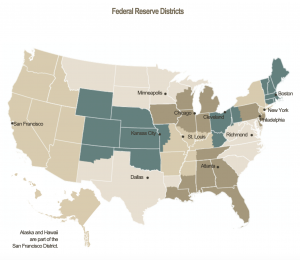Agriculture leaders in the United States House of Representatives are looking to provide at least an additional $10 billion in farmer aid to supplement the recently announced Farmer Bridge Assistance…
Federal Reserve: Observations on the Ag Economy- May 2021
On Wednesday, the Federal Reserve Board released its May 2021 Beige Book update, a summary of commentary on current economic conditions by Federal Reserve District. The report included several observations pertaining to the U.S. agricultural economy.

* Sixth District- Atlanta– “Agricultural conditions remained mixed. Widespread rain across much of the District resulted in abnormally moist to excessively wet conditions while the southern tip of Florida experienced abnormally dry to moderate drought conditions. Most of the region’s cotton and peanut crops were behind the five-year average, while soybean planting was mixed, and Tennessee’s corn crops were mostly on par with the five-year average.
Contacts reported some supply chain challenges, including the ability to acquire materials and equipment, higher input costs, and tighter labor availability.
“Several contacts noted land values increased.
* Seventh District- Chicago– “Expectations for farm income in 2021 strengthened across sectors in April and early May. Drought and dry weather conditions were an issue across a substantial portion of the District, though timely rains could still erase most of the impact. Frosts damaged some plants and trees, with potentially heavy losses for fruit producers. Corn and soybean planting proceeded ahead of the normal pace. Corn, soybean, and wheat prices moved up and were near multi-year highs. Hog, cattle, and milk prices rose, helped by strong meat and dairy exports. Egg prices dropped however. Despite higher prices, livestock producers’ margins were little improved because of higher feed costs.
Farmland values increased once again, because of strong demand and limited inventory.
* Eighth District- St. Louis– “Agriculture contacts remained optimistic about current conditions overall. Most agriculture contacts surveyed reported that their sales thus far have met expectations. Supply chain issues are raising many producers’ costs although higher commodity prices have helped generate higher incomes, maintaining profit margins. One contact indicated that government support has been strong in the sector. The percentage of row crops planted has increased since the previous reporting period and is up slightly from this time in 2020. Progress of acres planted is up slightly to moderately this year for every crop of the District states; only Indiana is behind their 2020 progress at this point. This optimism extends to the outlook as well, as contacts reported that their outlook for the rest of 2021 has improved somewhat.”
* Ninth District- Minneapolis– “Agricultural conditions improved sharply since the previous report. Contacts expected strong farm incomes heading into planting season, building on recent commodity price increases and export demand. Crop progress as of mid-May was generally well ahead of recent averages in District states. However, extreme drought conditions spread in portions of the District.”
* Tenth District- Kansas City– “The Tenth District farm economy remained strong, but drought continued to strain all types of producers in the western part of the region.
Contributing to the improvement in credit conditions, #farm income also strengthened rapidly.
— Farm Policy (@FarmPolicy) June 1, 2021
Respondents across all participating Districts reported higher incomes than a year ago for the second consecutive quarter https://t.co/ugEIf0XU8w @KansasCityFed pic.twitter.com/fpjFzluywp
“Prices for corn, soybeans, wheat, cotton, and hogs increased in recent weeks and remained at multi-year highs through the early part of May. In contrast, prospects for the cattle industry remained subdued as cattle prices were near pre- pandemic levels but profit opportunities were limited due to elevated feed costs. Alongside severe drought in the western portion of the District, the wheat crop was in poorer condition in Colorado relative to other states. Contacts also reported that the impact of drought on pasture quality and hay production continued to worsen.”
Strength in the #farm economy and low interest rates also supported farm real estate values in all regions during the first quarter.
— Farm Policy (@FarmPolicy) June 1, 2021
The value of nonirrigated cropland increased by 7% on average across all Districts https://t.co/ugEIf0XU8w @KansasCityFed pic.twitter.com/yiQAy2GrQt
* Eleventh District- Dallas– “Recent rainfall eased drought conditions in parts of the District and improved prospects for row crops. Agricultural commodity prices moved higher across the board, spurred by tight world supply and robust export demand. Overall, row crop farmers were optimistic for improved production and revenues this year. Significantly higher grain prices, however, have negatively affected the livestock sector with feed costs double what they were a year ago. Beef exports were strong, which together with continued capacity constraints in meat packing plants have driven up beef prices to well-above-average levels.”
#Farm loan repayment rates increased rapidly across the bulk of farm country in the first quarter.
— Farm Policy (@FarmPolicy) June 1, 2021
In aggregate, survey respondents reported an increase in the rate of loan repayment for the second consecutive quarter in most regions https://t.co/a32zEP6tIN @KansasCityFed pic.twitter.com/G72V0F5nCH
* Twelfth District- San Francisco– “Conditions in the agriculture and resources sectors notably improved. Loosened capacity restrictions in restaurants and drinking establishments contributed to stronger demand for agriculture products, including wheat, corn, nuts, and fruits. Demand from abroad also increased, aided by the depreciating dollar in the later part of the reporting period. As a result, inventories of fruits and nuts were noted to have decreased to lower- than-usual levels.
However, supply chain disruptions continued to negatively affect many producers with one reporting both domestic and international logistical is-sues that resulted in significant delays in seafood product sales.
“Growers in California noted that current drought conditions are expected to negatively impact annual crops this year, driving up labor and electricity costs as farmers depend more on wells and water pumps for irrigation.”





